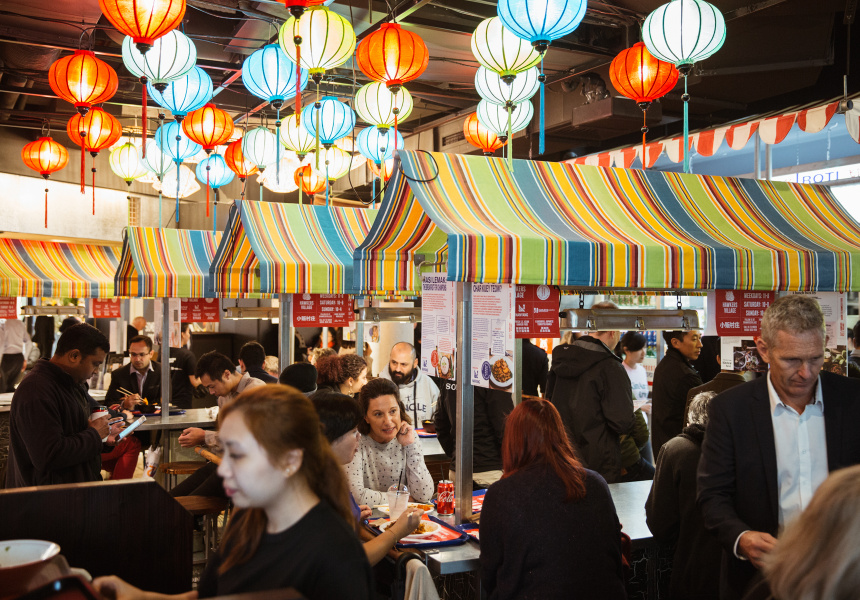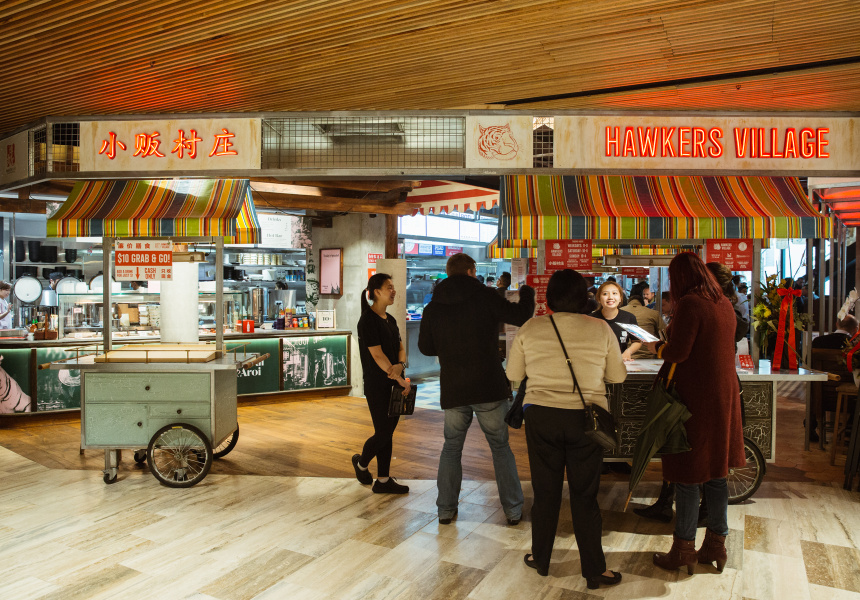If you don’t venture to North Sydney often, the hustle and bustle of the growing suburb might be a surprise. Although locals say it empties at night, by day the streets are crowded with office workers, and on every block there are new buildings rising up from behind plywood fences covered in band posters.
Many of the delicious hole-in-the-wall eateries have fallen to progress (RIP U2’s incredible Reuben sandwich). Some have moved to new spaces, while others have been replaced with an admittedly excellent food offering.
Bronx burger at Five Points Burgers – $14.50
For Driss Chikhaoui, owner of Five Points Burgers, the decision to open in North Sydney was purely practical. “There are high rises going up everywhere,” he says. “They expect in a couple of years the population of North Sydney will be 100,000.”
We think you might like Access. For $12 a month, join our membership program to stay in the know.
SIGN UPChikhaoui is serving a simple menu of five burgers, each named after a borough in New York City. The Bronx is Five Points’ take on a bacon and cheese burger and it’s a customer favourite. The fresh, medium-rare beef patty is topped with double cheese, bacon, house-made tomato sauce, aioli and onion jam plus pickles and American mustard.
“We make all our sauces here and the patties are pure beef. There’s no bonding agents, no colouring. We just add a little bit of salt and cook them fresh every day. The milk buns are from Brasserie Bakery, one of the best in Australia.”
Boat noodle soup at Hawker’s Village – $12
Hawker’s Village has the feel of a crowded Asian food market, complete with Thai-style handcarts used as high counters and large booths to accommodate big groups or punters eating alone. “People bump elbows while they’re eating,” says owner Raymond Fan. “We created it this way intentionally because it’s exactly what it’s like when you go to hawkers in Asia.”
The food is just as authentic. Boat Noodle Soup is served hot, the dark broth filled with a twist of rice noodles, fish and beef balls, and scented with cinnamon, star anise and other secret spices that give a hint of chocolate.
“I think Thai boat noodles are overlooked in Australia, but they’re a really important part of Thai culture. In Bangkok, people’s lives revolve around the canals and the floating market. At lunch, they wait for the dong of the bell – each boat has a different tone – you go to the canal and wave at your favourite boat to ask them to make you soup.”
Although the flavour is authentic, the soup has been adjusted for Western palates. Pig’s blood is normally the finishing ingredient. “We decided to make it without blood to make it more approachable.”
Japanese omelette sando at Devon – $8
Devon’s omelette sando is loosely based on the Japanese egg sandwich sold in convenience stores all over Japan. “We make it to order on thick-cut fluffy white bread with Japanese mayo and a rice seasoning called furikake. It’s very tasty, very umami,” says owner Zachary Tan. “We put a bit of chives and make the omelette fresh so it’s nice and warm.”
The high risk of screwing up an omelette isn’t lost on Tan. “It’s hard to make an omelette, to control the heat and to make sure it’s juicy inside but still set. If you cook it too much it’s dry, or not enough it’s like scrambled eggs and falls apart inside the bread.”
Devon’s version is consistently well done; the omelette is cooked seconds past the wobbly stage. And like its Japanese convenience store cousin, it’s cheap.
Lamb Provençale pie at St Honoré Bakery – $6
St Honoré opened in North Sydney at the turn of the millennium, specialising in breads, cakes and pastries. Named for the French patron saint of bakers – story has it he used to pull all-nighters baking to feed the poor – the business has thrived and now has bakeries in Edgecliff and Mosman.
After nearly 20 years in business, the pies have attracted a loyal following. “Lots of people have written about us. If you see an article about the top-10 pies in Sydney, we’re on it,” says manager Hany Buttrose.
Buttrose says although the traditional beef mince pie is popular, his favourite is the lamb Provençale. “I think it’s the best one we have. It has a little bit of sherry and the secret ingredient is eggplant. A lot of people love it and have no idea what’s making that flavour. The eggplant is a beautiful thing.”
Like the rest of St Honoré’s offering, puff pastry and pie fillings are made on premises. “Sometimes people find a bay leaf in their pie and they come and thank us because they know it’s made from scratch.”
Rare beef pho at Viet’s Pho – $15
Viet’s Pho is so busy during lunchtime there’s a condiment station where customers dress their own soup after it appears at the kitchen pass-through. A polite sign on the wall requests customers help with the clean up by returning plates to the counter. “Even though this place is big, sometimes we’re so busy at lunch we don’t have enough seats,” says owner Khanh Mai.
Viet’s Pho serves a variety of dishes, but its namesake soup is the best. Mai invites Broadsheet into the kitchen to watch as he lays thin slices of rare beef in a pattern on top of freshly cooked noodles and pours boiling soup over the lot. The colour of the beef changes instantly. “You have to cook the soup very hot,” he says. “For rare beef, we use the topside and of course it has to be the really fresh one. You can even eat it raw, it’s so fresh.”
He won’t divulge the secret to the shop’s pho recipe, and will only say it comes down to good, marrow-rich beef bones and a long, 12-hour cooking time. It’s balanced and although hoisin, Sriracha and lemon are available, the flavour requires no meddling. But make sure to try both types of chilli: the roughly pounded fresh bird’s eye chilli and a smoky house-made dried chilli oil.
Hainanese chicken rice at Hawker’s Village – $13
Raymond Fan says it’s near impossible to produce a perfect Hainanese chicken rice. “There are four elements: rice, chicken, chilli sauce and the soup. Very few people can make every element well.”
He even turns his critical eye on the version at Hawker’s Village. “I love Hainanese chicken rice, and I think ours is the best, but in Australia it’s never perfect because the base needs to be made with what we call ‘running chicken’. Only totally free-range chicken will give you the tenderness and colour of a true chicken rice.”
There are many stories about the dish’s origins. Malaysians claim it as theirs; Singaporeans as theirs; but Fan says it’s a dish that picked up characteristics as it travelled from Hainan in China through Southeast Asia.
Lemongrass was added to the Chinese recipe and depending on whether it’s Thai-style or Malaysian, it’s served with a different chilli sauce. Hawker’s Village provides both: a meaty, tangy, hot Malay chilli sauce and a sweeter, more liquid Thai version. Plus a dish of thick, sweet soy sauce.



